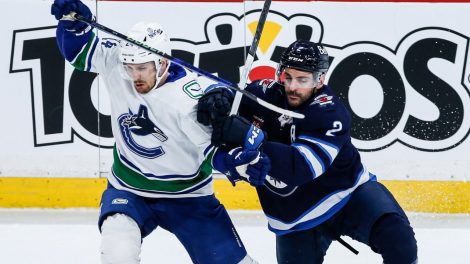The NHL today looks nothing like it did 10 years ago.
In the 2010s, the game has evolved thanks to a wide range of analytics, the high speeds of three-on-three overtime and a new generation of stars arriving on the scene.
But before you flip the calendar to 2020, let’s take a look back at 10 numbers that defined the NHL during the past decade.
Numbers through games on Dec. 29.
437 — The number of goals scored by Alex Ovechkin
Wayne Gretzky has the record, but Alex Ovechkin made a strong case this decade that he is the greatest goal scorer of all time. Ovechkin scored a league-best 437 goals this decade and the Washington Capitals captain was the only player to get at least 30 goals in all 10 seasons. He then added another 50 goals in the playoffs — the most in the decade as well — helping his team win the Stanley Cup in 2018.
Ovechkin won the Maurice Richard Trophy as the league’s top scorer six times this decade, giving him eight for his career — an NHL record.
Now 34, Ovechkin heads into the 2020s needing only 213 goals to break Gretzky’s all-time record. If anyone can break it, it’s him and at his age he still has plenty of time to do it.
10 — The number of different Hart Trophy winners
For the first time since the award was introduced in the 1920s, there were no repeat Hart Trophy winners in the 2010s. Nine of the winners were forwards, but Carey Price took the crown in 2015, becoming the first goaltender to win in 13 years.
The Hart Trophy created some heated debate this decade over whether the award should be given to a player on a team that didn’t make the playoffs. Regardless of what side of the argument you fall on, all 10 winners did make the playoffs the year they won, but none of them won the Stanley Cup.
While MVP didn’t have any repeats, some of the other top awards did. Erik Karlsson and Duncan Keith each won the Norris Trophy twice as the top top defenceman, Sergei Bobrovsky took home two Vezina Trophies as the league’s top goaltender and Patrice Bergeron won the Selke Trophy as the top defensive forward four times, putting him in a tie with Hall of Famer Bob Gainey for the most all time.
2 — The number of cities awarded expansion teams
The NHL expanded to Las Vegas in 2017 and it couldn’t have been a bigger success. The Golden Knights, led by Marc-Andre Fleury in net, reached the Stanley Cup Final in their very first season, ultimately falling to the Capitals in five games.
[sidebar]
In the year and a half since, the club has swung big trades for Mark Stone and Max Pacioretty and appears poised to be a playoff threat for years to come.
While the Seattle Fill-In-The-Blanks won’t take the ice until the fall of 2021, the NHL’s 32nd team has already made some game-changing additions to its hockey operations department, including stats guru Alexandra Mandrycky and Hall of Famer Cammi Granato as the first female pro scout in the NHL.
58.3 — Patrice Bergeron’s Corsi For Percentage
Analytics took centre stage for the first time this decade. While stats like Corsi, Fenwick and PDO existed in fan blogs before 2010, this decade saw them become more mainstream as everyone looked for a competitive edge.
Now teams have full departments dedicated to advanced statistics, coaches get reports about player usage rates and shot locations, and even broadcasts are starting to incorporate the information.
Patrice Bergeron is the perfect player for the analytics era and no one had a better Corsi For Percentage than his 58.3, per Hockey Reference.
One other fascinating side effect from the stats movement has been the emergence of next-gen general managers. John Chayka was only 26 when the Arizona Coyotes promoted him to general manager in 2016, but he had already served as assistant GM and founded a hockey-analytics company called Stathletes. Similarly, Kyle Dubas embraced advanced statistics with the OHL’s Soo Greyhounds and now finds himself running the Toronto Maple Leafs at age 34.
787 — The number of games played by Phil Kessel
Phil Kessel was the only player to play in every possible game this decade and he hasn’t missed one since October of 2009. Not bad for someone who apparently eats too many hot dogs.
Kessel’s story is a classic example of how much things can change for a player in one decade. In 2010, he was in his first season with the Toronto Maple Leafs and was immediately put under the microscope after a first-rounder the Leafs traded to the Bruins for him turned out to be the No. 2 pick in the draft. While Boston would win the Stanley Cup the next season — with that pick, Tyler Seguin, playing a small part — Kessel did everything he could to help Toronto, leading the team in scoring in all six of his seasons there.
But the team could never put things together and Kessel was traded to the Pittsburgh Penguins in 2016. Once in Pittsburgh, Kessel thrived as the third star on a great team, won the Stanley Cup in his first two seasons with the club, then set a career high of 92 points in his third. Now in Arizona, Kessel will be counted on to help the Coyotes make the playoffs for the first time in eight years.
And he did it all without missing any games.
4 — The number of times the Edmonton Oilers had the No. 1 draft pick
Every Canadian team had some good fortune in the NHL Draft this decade, but none more than the Edmonton Oilers. The Oilers picked first overall four times — including in three consecutive drafts from 2010-12 — and hit the jackpot when they jumped up two spots in the lottery to select Connor McDavid in 2015.
While McDavid has become an instant star and Taylor Hall won an MVP award (with the New Jersey Devils) the Oilers also learned a hard lesson in development when they took Nail Yakupov — who now plays in the KHL — first in 2012.
The Maple Leafs were the only other Canadian team to pick first overall this decade — grabbing Auston Matthews in 2016 — but all seven Canadian teams had at least one top five pick, giving hockey fans north of the border plenty of new stars to cheer for.
| Team | Player | Draft Pick | Year |
|---|---|---|---|
| Calgary Flames | Sam Bennett | 4 | 2014 |
| Edmonton Oilers | Taylor Hall | 1 | 2010 |
| Ryan Nugent-Hopkins | 1 | 2011 | |
| Nail Yakupov | 1 | 2012 | |
| Leon Draisaitl | 3 | 2014 | |
| Connor McDavid | 1 | 2015 | |
| Jesse Puljujarvi | 4 | 2016 | |
| Montreal Canadiens | Alex Galchenyuk | 3 | 2012 |
| Jesperi Kotkaniemi | 3 | 2018 | |
| Ottawa Senators | Brady Tkachuk | 4 | 2018 |
| Toronto Maple Leafs | Morgan Rielly | 5 | 2012 |
| Mitch Marner | 4 | 2015 | |
| Auston Matthews | 1 | 2016 | |
| Vancouver Canucks | Olli Juolevi | 5 | 2016 |
| Elias Pettersson | 5 | 2017 | |
| Winnipeg Jets | Patrik Laine | 2 | 2016 |
3 — The number of skaters per team in overtime
The NHL brought in 3-on-3 overtime in the regular season for the 2015-16 season and it’s changed the game for the better. With one less body on the ice per team, overtime now rewards speed and often becomes a series of two-on-one opportunities.
The NHL hoped to cut down on shootouts with the rule change and the data shows that it’s working. In the last five seasons of 4-on-4, there were 775 shootouts and only 597 games settled in overtime. By comparison, there has been only 448 shootouts and 833 games settled in overtime in the four-and-a-half seasons with 3-on-3.
2.76 — The average number of goals per game
Despite young stars dominating the scoresheets across the NHL, overall scoring remained relatively flat this decade. The 2.76 goals per game teams scored this decade matches the 2000s, but before that scoring hadn’t been this low since the 1950s.
Jamie Benn made history in the 2014-15 season by winning the Art Ross trophy with only 87 points, the lowest total for a league scoring leader (in a full season) since 1968. Since then, scoring has slowly started to rebound and last season six players hit the 100-point mark and 16 had more than 87.
One reason scoring has been down is that the goalies have gotten better. While the league has made some changes to goalie equipment in an attempt to increase scoring, 30 goalies (who played at least 100 games) posted a save percentage above .915. By comparison, only nine did that in the 2000s, while Dominik Hasek was the only one to do it in the ’90s and Patrick Roy led the ’80s with only .896.
While we’re a long ways removed from the high-scoring ’80s and early-’90s, if the next generation of shooters can lift scoring across the league, everyone — except the goalies — will benefit.
[relatedlinks]
3 — The number of teams that won multiple Stanley Cups
For the first time since the 1930s, three teams won multiple Stanley Cups in a decade. The Chicago Blackhawks came out on top three times in 2010, ’13 and ’15 while the Los Angeles Kings won in 2012 and ’14, and the Pittsburgh Penguins went back-to-back in 2016 and ’17 — the first team to do that in 19 years.
The Blackhawks were the first example of a dynasty in the salary cap world and were dealt heavy losses to their roster after every championship because they couldn’t afford to keep everyone. That’s why the Penguins winning back-to-back was so impressive — it’s very hard for good teams to stay together in the cap era.
While the days of teams winning four or five titles in a row are probably gone, these three teams showed dynasties are still possible in the modern NHL.
$100 million — The value of Connor McDavid’s contract
While Connor McDavid isn’t the first player to sign a nine-digit contract, he still changed the game when he put his name on the dotted line of an eight-year, $100-million deal in 2017.
Before that, star players signing their second contract would get a modest raise from their entry-level deal. But McDavid’s second contract raised the bar and suddenly players such as Auston Matthews, Mitch Marner and Jack Eichel were asking for as much as they could get.
The impact McDavid’s contract had on the market was most apparent during the 2019 off-season, when a record number of restricted free agents waited until training camps opened before coming to terms with their teams. While McDavid’s $12.5-million cap hit is still the ceiling, data from CapFriendly.com says that 41 players will earn at least $9 million in salary this season, including nine players under the age of 25.









